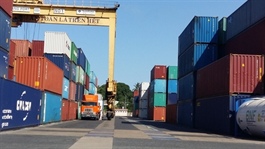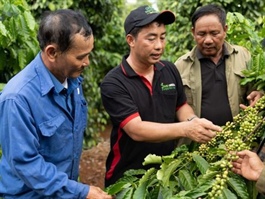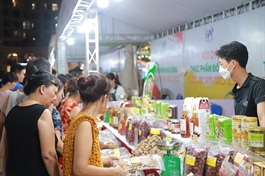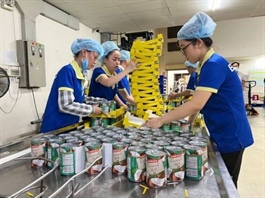Vietnamese agricultural sector urged to overhaul logistics for improved export potential
Vietnamese agricultural sector urged to overhaul logistics for improved export potential
Experts recommend that Việt Nam establish a specialised logistics and transportation system for its agricultural sector, tailored to accommodate a wide variety of agricultural goods.
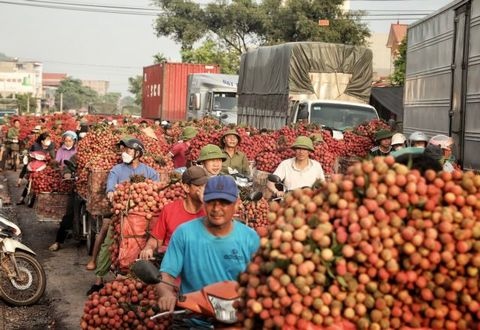
Lychees are transported in Phượng Sơn Commune, Lục Ngạn District, in the northern province of Bắc Giang. — VNA/VNS Photo Danh Lam |
This will aid in preserving the quality of produce destined for international markets while facilitating the comprehensive development of domestic agriculture, encompassing production, processing, and consumption.
Nguyễn Thanh Bình, the chair of the Việt Nam Fruit Association (VINAFRUIT), noted that the fruit and vegetable sector is grappling with numerous challenges related to exporting, particularly to distant markets with rigorous standards.
Presently, the infrastructure designed to facilitate this commodity is lacking, contributing to substantial post-harvest losses, estimated to be around 30-35 per cent. This scenario results in significant economic repercussions, Bình pointed out.
In addition, antiquated preservation technology is causing a decrease in the quality of fruits and vegetables, hampering their competitiveness in global markets, he said.
While Vietnamese fruits and vegetables have garnered favour among consumers worldwide, logistical and preservation challenges remain significant hurdles for both producers and exporters, according to Bình.
Exporters of fruits and vegetables find it particularly challenging to transport various types of produce to discerning markets like the United States and Europe. Despite their popularity in these regions, the inability to ensure efficient logistics has deterred businesses from exporting certain types of fruit, Bình concluded.
Nguyễn Đình Tùng, Chairman of the Board of Directors at Vina T&T Group, indicated that for dragon fruit to be exported to the American market, exporters must guarantee a shelf life of 35 days.
However, he pointed out that the utmost quality of dragon fruit, post-irradiation, lasts for a mere 27 days.
Similarly, the peak quality of star apple fruit, following irradiation, extends only to 10 days. This necessitates the use of air transport for exporting the star apple to the US, he further explained.
"Yet, the transport costs prove exorbitant for sustained exporting," he added.
Phạm Văn Trọng, deputy chairman of the People's Committee of the Mekong Delta province of Tiền Giang, stated that the province has successfully exported fruit products to numerous global markets.
Nevertheless, he lamented the fact that if the high transportation costs are coupled with a lack of preservation technology and standardised warehouses, it represents a significant missed opportunity.
The resulting high post-harvest losses, attributed to subpar storage conditions, lead to substantial revenue losses, he highlighted.
Furthermore, he noted that synchronising technology application within logistics also plays a pivotal role in preserving agricultural produce post-harvest, in line with market requirements.
High logistics costs
In Việt Nam, the high cost of shipping agricultural products is often due to these goods being purchased by a multitude of buying units directly from the producers. The sheer number of purchasing units, and the diverse stages involved, inadvertently inflate the shipping costs of agricultural commodities.
As per the data from the Việt Nam Logistics Business Association, logistics expenses for agricultural products in Việt Nam were 6 per cent higher than in Thailand, 12 per cent more than in Malaysia, and triple that of Singapore in the recent past.
A 2022 report from the global logistics group, Agility, revealed that logistics costs in Việt Nam account for approximately 20 per cent of GDP, which is double the rate seen in developed nations.
Nguyễn Tú Uyên, director of CMU Logistics Transportation Services Company Limited, stated that agricultural goods from the Mekong Delta must traverse through a variety of transport modes. These range from three-wheeled vehicles to lorries, and boats to reach a central location, owing to the multitude of narrow and minor rural roads scattered throughout the delta.
She described the logistics system in the region as small and dispersed.

Farmers in the initial processing of Phước Bình pomelos in Bắc Ái District, Ninh Thuận Province. These pomelos have been approved by the United States Department of Agriculture (APHIS) and have received a planting area code, qualifying them for export to the market. — VNA/VNS Photo |
The quality tends to decrease while selling prices of agricultural products tend to increase due to the numerous transportation stages involved, Uyên explained.
At present, numerous agricultural commodities have been given a planting area code by significant markets such as China and the US, or have been certified as having a production process equivalent to the standards of these countries. Yet, inadequate logistics still pose challenges to exporting these agricultural goods, she pointed out.
Taking Bắc Giang lychees as an instance, Uyên noted that these fruits must travel from Bắc Giang to Hà Nội and then to HCM City, before reaching the irradiation and export packing facilities.
This extensive journey inadvertently diminishes the quality of the lychees and shortens their preservation duration, she elaborated.
Uyên emphasised that if all aspects of the logistics process are tightly interconnected, it could potentially decrease logistics expenses and extend the storage lifespan not just for lychees, but for other fruits as well.
Solutions
Trần Công Thắng, director of the Institute of Policy and Strategy for Agriculture and Rural Development, recommended the creation of a logistics system that connects the production area with both domestic and export markets for the local agricultural sector.
He proposed a three-tier logistics centre system.
The first tier consists of logistics centres affiliated with the production area, and the second involves regional logistics centres that act as a catalyst to link the production area with significant markets, he explained.
The third tier comprises logistics centres servicing imports and exports, ideally located at border gates experiencing extensive trade with neighbouring countries, he added.
Consideration should also be given to the quality of traders to develop a comprehensive logistics hierarchy, he stated.
Trần Thanh Nam, deputy minister of Agriculture and Rural Development, revealed data indicating that there are over 5,000 logistics enterprises operating in Việt Nam, with domestic firms accounting for 89 per cent. The majority of these businesses are small to medium-sized enterprises.
These companies facilitate the shipment of 67 per cent of Vietnamese agricultural products by sea and 7.5 per cent by air to markets in Europe, the United States, and Australia.
Nam stressed the need to enhance all components of the agricultural products' logistics system to ensure that Vietnamese produce can conveniently reach global markets while preserving its innate quality.
The logistics system should be clearly segmented, based on the topography and traffic conditions of each region, to facilitate easy and convenient connections, he concluded.
The ministry has suggested Cần Thơ City as a hub for initial processing, packaging, and logistics within the Mekong Delta region. This would serve as a central point for the region's agricultural products, ensuring coordinated processing prior to export, he shared.
Additionally, Nam emphasised the need for enhancing infrastructure such as dual-purpose warehouses for storage and packaging of high-quality agricultural product groups; the development of new markets along transportation routes; research into combining transportation of diverse items; and coordination among businesses within the same sector to optimise efficiency and minimise costs.
For this to materialise, localities must encourage local businesses to contribute and utilise resources and materials unique to each region in the most efficient manner, he stressed.
Nam further underscored the importance of developing a logistics system for the e-commerce of agricultural products. He characterised this as a promising consumption channel, potentially becoming the main route of consumption, should a pandemic or economic instabilities arise.





